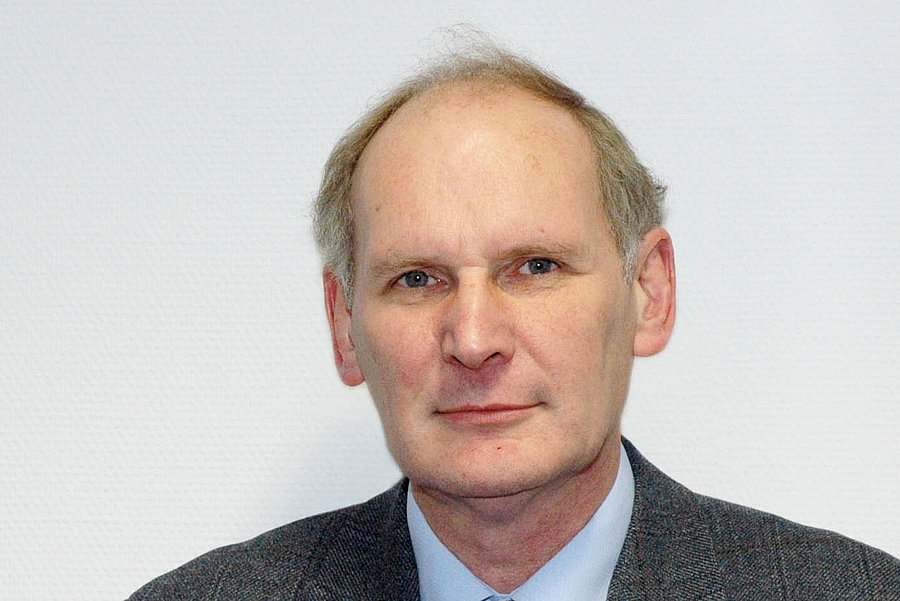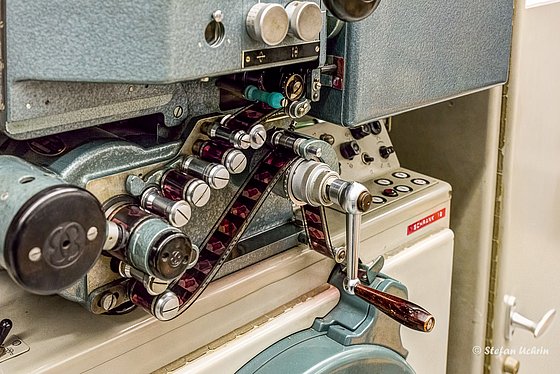
Invention of the sound-on-film process
Prof. em. Dr.-Ing. Uwe E. Kraus / Communications Engineering
Photo: Press Archive University of Wuppertal
When the silent film got a voice
The invention of the sound-on-film process
An interview with Prof. em. Dr.-Ing. Uwe E. Kraus, long-time head of the Department of Communications Engineering at the University of Wuppertal.
The German engineer Hans Vogt was one of the inventors of the new light-tone process in the early 1920s. Together with Joseph Massolle and Joseph Benedict Engl, he founded the company "Tri-Ergon", which means "the work of three". What was revolutionary about this invention?
Kraus: After decades of using silent film, it was now possible to make the actors' voices, ambient sounds and accompanying music audible for the first time. In this process, the sound of a motion picture film was stored photographically on a maximum 2.54 mm wide strip called a sound track between the film frames and the perforation holes of the film. For this purpose, the electrical sound signal controls the brightness of a lamp, the light of which falls on the aforementioned sound track via a narrow transverse slit and causes analog blackening of the film in the running direction in addition to the sound signal.
For mass distribution, the advantage of the optical sound process is essentially that the film images and the sound track are copied together when the film copies are made. In addition, the optical soundtrack is fixed in terms of location and time with respect to the film images, and is therefore always lip-synchronous. It thus cannot be accidentally erased, as it is the case with magnetic sound. The disadvantage (as with the actual film image) is the susceptibility to scratches, which can lead to sound disturbances. But, even with an undamaged film, the sound frequency range is limited, but this was not considered as annoying at the time.

What happens technically in the projector during this process?
Kraus: A small lamp of constant brightness in the light sound unit illuminates the sound track through a narrow slit oriented transversely to it.
The brightness of the light emerging from the opposite side of the film fluctuates in accordance with the variable blackenings on the sound track. This is converted by a photocell into an electrical signal, i.e. into the reproduced sound signal, and fed, via amplifiers to the loudspeakers, in the cinema auditorium.
For projection, the film is moved downward in steps/images between freely oscillating loops, one above and one below the image window. During projection, the film image in the image window stands still; during the film transport to the next film image, a rotating wing shutter interrupts the light in the direction of the screen.
The sound track, on the other hand, must be read from a constantly running piece of film. In the sound recorder, the so-called sound shaft, which is connected to a flywheel, ensures that the film runs smoothly and evenly. This happens, looked at in the film running direction, behind the projection lens of the projector. Because of these technically different reproduction conditions, the image and sound track on the film are offset from each other. A sound event is therefore not located directly next to the corresponding image but 20 frames ahead of it in the running direction.
To this end, the three German engineers developed new photocells based on electron tubes and applied for about 150 patents. Nevertheless, the invention was not successful in Germany, even after the first light-sound performance on September 17, 1922, at the Alhambra movie theater in Berlin. Why not?
Kraus: It was essentially the technical deficiencies.In 1925, one of the three, Joseph Benedict Engl, was responsible for the sound of the short film "Das Mädchen mit den Schwefelhölzern" (The Little Match Girl), based on the fairy tale by Hans Christian Andersen and produced by "Universum-Film AG" (UFA) in Berlin. However, the premiere had to be canceled due to considerable technical deficiencies; the film became a commercial failure.
The sound film patents were sold to the American William Fox, who made the sound film world famous from 1928 and who was able to live well off the Tri-Ergon patent until the end of his life, even after the stock market crash. Over the years, other processes were also used, such as the magnetic sound process. What advantage did this process offer in the film industry?
Kraus: Magnetic sound processes allow better sound quality than sound-on-film processes. Professional processes with SEPMAG (separated magnetic) worked with magnetic film, i.e. a perforated sound tape of 16 mm, 17.5 mm (2 sound tracks each) or 35 mm width (up to 6 sound tracks), which was played in parallel and synchronously with the picture film on a mechanically or electrically coupled cord machine with multi-track sound heads.
When the film was shot, the original sound was first recorded on portable tape recorders (Nagra) with an additional synchronized sound track (50 Hz) and later recorded on magnetic film with an electrically synchronized cord machine. The classic elements of dialogue, sound (effects) and music could be cut onto magnetic film on cutting tables with three sound tracks. They were then ready for mixing in the dubbing studio with film projector and several cord machines coupled to it.
The COMMAG (combined magnetic) magnetic sound process was widespread from the 1950s to the 1980s; in this process, the narrow magnetic tape was stuck directly onto the film and played back in a projector with a pickup system. The advantage of this was that only one device was needed instead of two, and synchronizing picture and sound was no longer a problem.
Dolby Stereo, a new groundbreaking sound system, hit theaters in 1976. Cinemagoers were able to admire this process for the first time in the film "Tommy" by the rock group The Who. What was new about it?
Kraus: The Dolby A noise reduction system improved the sound quality considerably. Quiet sounds are raised in volume before the film is described and lowered again by the same amount during playback. This lowers the annoying film sound noise and significantly improves the signal-to-noise ratio.
It was also possible to accommodate two light sound tracks in the space that one track used to require, and to still accommodate the information for a surround channel (rear effects and reverb components) and a center channel (dialogue track) in these two tracks. That was the beginning of Dolby Stereo.
What sound systems do professionals work with today?
Kraus: Dolby SR is a noise reduction process in use since 1987 for sound recording on analog optical sound on 35 mm film. SR stands for spectral recording and is named this way because it has a spectral compressor function adapted to the ear. The process is the most highly developed audio noise reduction process and marks the end of the development of these analog processes, since noise reduction is no longer needed for digital systems.
Dolby Digital was first used as a multi-channel sound format for motion pictures (e.g. Apocalypse Now) and in 1995 was chosen as the standard multi-channel sound for the then newly developed DVD (Digital Versatile Disk) as well as for television broadcasting. It is a 6-channel (5.1) digital system and is also known as AC-3 according to the audio encoding process used.
Dolby Atmos is an elaborate surround format for home and cinema use that was introduced in 2012. The format expands purely channel-based surround sound systems with multiple ceiling speakers and theoretically allows an unlimited number of audio tracks; it is backward compatible with older multichannel sound systems such as 5.1 or 7.1.
Uwe Blass (Interview on January 7, 2021)
Uwe E. Kraus held the Chair of Communications Engineering in the Faculty of Electrical Engineering, Information Technology and Media Technology at the University of Wuppertal until his retirement in 2010. His predecessor in office, Prof. Dr. rer. nat. Dr. h.c. F.J. In der Smitten, had set up a color television test laboratory at Westdeutscher Rundfunk Cologne in the 1960s and, after his appointment at the University of Wuppertal, brought essential apparatus from this laboratory with him to Wuppertal; this was used for research and teaching.
Prof. Kraus and Prof. In der Smitten have arranged and operated these devices from the pioneering days of color television in Germany in roughly the same way as they were in the Cologne laboratory at the time.
Now called the "Historical Color Television Laboratory at the University of Wuppertal," it offers insights into the transformation of television studio technology over a period that spans from the post-war relaunch of black-and-white television in 1952, through the launch of color television in 1967, to the beginnings of digital television in the mid-1990s.
The Historical Color Television Laboratory can also be visited; registration for guided tours are possible at the e-mail: hffl@lists.uni-wuppertal.de.
